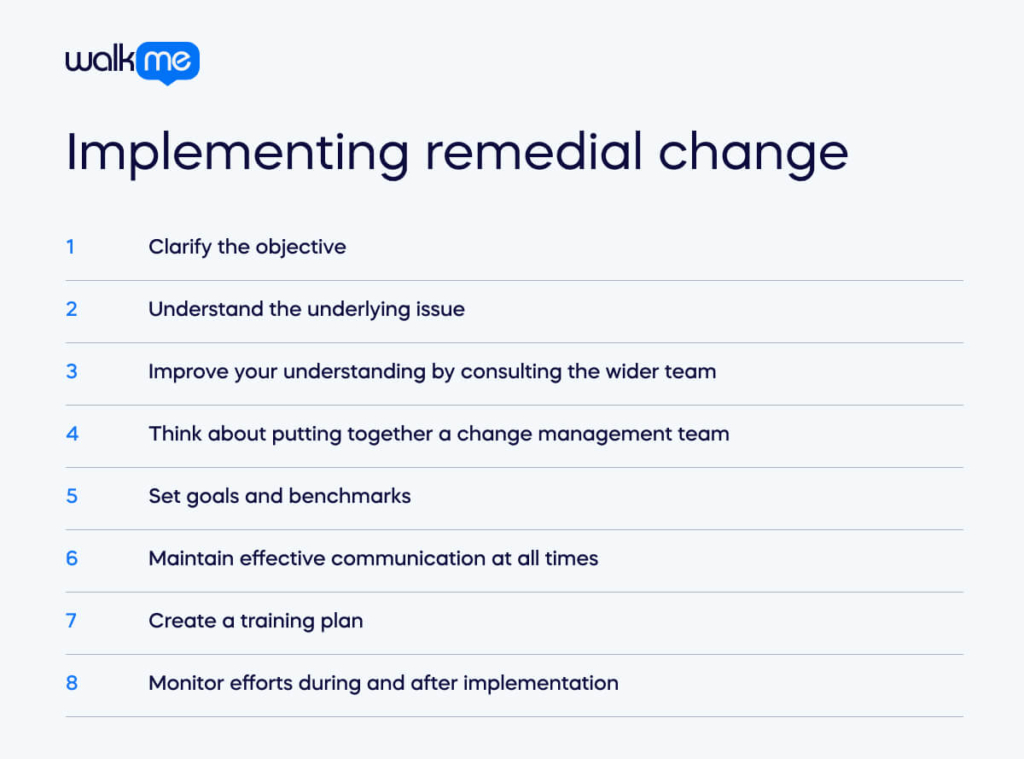Organizations change for many reasons, often in response to cultural, societal, behavioral, or technological shifts. Adaptation is essential for organizational health and growth, but some changes arise not from opportunity, but from urgent problems that need fixing.
Remedial change focuses on addressing immediate issues that threaten performance or stability. This might involve reducing workplace burnout, closing a budget shortfall, improving underperforming teams, or shifting from a reactive stance to a proactive one. Because these changes are designed to resolve pressing problems, their impact can usually be measured by whether the issue is successfully addressed.
Implementing remedial change effectively requires more than quick fixes. Strong change management ensures that employees understand the reasons behind the shift and remain committed to making improvements sustainable.
This article will explore the purpose of remedial change, its distinction from preventative measures, strategies for implementation, real-life examples, and the pros and cons.
What is remedial change?
Remedial change, similar to unplanned change, is reactive by nature. It occurs when an issue arises, necessitating the implementation of a solution. Because these changes aim to fix a problem, they require swift action.
Though not always the preferred route, reactionary change is part of the process. The advantage of remedial change lies in its straightforward evaluation criterion: has the issue been resolved? The process starts with identifying a problem and concludes with deploying a solution.
The simplicity is deceptive, as being reactionary often means navigating through some degree of trial and error. The need for rapid response limits the time available for thorough planning and smooth transition.
The effectiveness of the remedial strategy is assessed by monitoring the outcomes, with success defined by the resolution of the initial problem. Instances of remedial change might involve implementing additional employee training for the customer service staff to lower complaint rates or introducing automation to enhance efficiency and cut costs in a specific department.
What is the purpose of remedial change?
Remedial change aims to address issues related to performance improvement or organizational culture. While such changes might appear punitive to the individuals or teams involved, they aim to deliver constructive feedback, assist in challenging circumstances, or eliminate harmful elements within the workplace to prevent more significant problems.
These changes are characterized by their specificity and immediacy as they target identified problems. The nature of remedial change is constrained and time-sensitive, making evaluating its effectiveness straightforward in terms of success or failure.
What is the difference between remedial and preventative change?

Remedial changes are reactive measures taken to address the root cause of an issue after it has emerged, in contrast to preventive changes, which are proactive efforts to identify and resolve potential problems before they occur.
Preventive measures involve forecasting potential issues and taking proactive steps to stop them from occurring. Measures include employee and worker engagement in enhancement teams, meetings focused on improvement, and seizing improvement opportunities during internal audits, management reviews, and customer feedback sessions.
Additionally, setting specific objectives related to business expansion, minimizing rejections, and optimizing equipment use, among others, further drives a preventative change initiative.
However, this distinction does not preclude integrating both approaches as part of a proactive change management strategy.
For instance, if a product’s marketing strategy fails, immediate remedial change actions, such as price reduction, can be implemented. Simultaneously, a proactive stance might involve reviewing and enhancing the overarching marketing strategies for all products and investing in additional staff training.
This approach ensures they are better equipped to devise compelling customer offers, blending remedial and preventive strategies for a comprehensive solution.
Implementing remedial change

Although each remedial change is tailored to specific needs, its likelihood of success substantially increases when executed through a structured process. This involves thoroughly contemplating the challenge, securing the necessary resources, and undertaking the change with backing from essential stakeholders.
Consider the following crucial points before implementing your following remedial change:
Clarify the objective
Start by defining the specific issue that needs remediation and what success will look like. This step is crucial to prevent the scope of the objective from expanding indefinitely, which can lead to a loss of focus and an inability to achieve the original goal. Establishing a clear end goal ensures that efforts remain targeted and effective.
Understand the underlying issue
Even with existing quality guidelines or standard operating procedures, deep-seated challenges might prevent their successful implementation.
Engaging in a thorough analysis is critical to uncover the real issues. Employing established root cause analysis techniques helps accurately identify these underlying problems, thereby setting a solid foundation for the remedial process.
After identifying the problem’s root cause, the following steps involve evaluating triggers of nonconformance and identifying related issues. This phase is about crafting solutions that address the identified problems while integrating risk management protocols to mitigate future occurrences.
Establishing clear responsibilities and setting an adequate timeline for the remedial change implementation are essential for structured progress.
Improve your understanding by consulting the wider team
Dialogue with team members is invaluable for comprehensively understanding the problem. This conversation can reveal whether the issue is a recurring one or a singular event.
If it’s the latter, it might be more prudent to allow the problem to be resolved independently rather than initiating a remedial change that could introduce new complications.
Analyze the issue’s impact on critical business operations by considering the context and frequency of its occurrence. It’s important to differentiate between problems affecting essential aspects of your business, like the entire supply chain or overall customer experience, and those less pervasive.
This assessment helps prioritize which problems require immediate action and which can be scheduled for later resolution.
Think about putting together a change management team
The scope of the remedial change will dictate the team’s size and composition needed. Consider who will handle data and reporting, who will communicate with stakeholders, and whether a subject matter expert should be part of the team. Ensuring the right mix of skills and responsibilities is vital to the plan’s success.
Determine the roles of all individuals, teams, and even clients who need to be involved in the remedial change. It’s crucial to communicate why their involvement is necessary and how the project’s success benefits them.
This ensures leadership buy-in and support across various functions such as operations, compliance, technology, and sales, keeping these groups aligned throughout the change process.
Set goals and benchmarks
Develop specific, clear, and achievable goals to guide the remedial process. Instead of setting a few significant, vague objectives, focus on creating numerous small, measurable goals. These smaller goals facilitate easier progress tracking and provide regular milestones that boost morale and give a sense of achievement.
Maintain effective communication at all times
Communicate clearly, simply, and tailored to the audience. Regularly convey the overall objective of the remedial change, adjusting the message as needed to keep all stakeholders informed and engaged. This continuous communication is vital for reminding everyone involved of the change’s importance and ensuring alignment with the project’s goals.
Create a training plan
Outline a comprehensive training plan that covers the knowledge, understanding, skills, and confidence required to comply with the remedial action plan. The extent of the training will vary depending on the change’s scope—from a few hours for individual-focused changes to weeks or months for organization-wide initiatives.
Monitor efforts during and after implementation
Monitor the implementation of the remedial change closely to identify any need for adjustments. This helps track progress and demonstrates a commitment to the improvement process, reinforcing the seriousness of the initiative.
After the implementation, conduct a thorough review to determine if the issue has been effectively resolved. If the problem persists, refine the approach and repeat the process until it is successful.
Continuously document any lessons learned to improve the handling of similar issues in the future, enhancing business resilience and adaptability.
Practical examples of remedial change
In addition to having some best practice guidelines for implementing remedial change, here are two examples of organizations that have dealt with remedial change:
Wells Fargo
Between 2002 and 2016, Wells Fargo was involved in a scandal where employees created millions of unauthorized accounts for its customers, driven by the pressure of unattainable sales targets. This misconduct led to a settlement with the U.S. government in 2022, resulting in the bank agreeing to pay a $3 billion fine.
In response to these events, starting in 2019, Wells Fargo has embarked on a comprehensive transformation of its operational structure. This includes dividing its three business units into five and establishing four new Enterprise Functions to enhance oversight and ensure transparency.
Moreover, the bank has undergone significant leadership changes, with 12 out of 17 Operating Committee members and over half of the leaders appointed directly below the Operating Committee since October 2019.
These new leaders are tasked with integrating stronger risk management accountability into the bank’s performance management and compensation frameworks.
Additionally, Wells Fargo has bolstered its capability to detect and address operational risks by establishing a new control management organization and program. Another key initiative is the creation of the Office of Consumer Practices.
This new entity serves as an enterprise-wide advisory body focused on incorporating consumer feedback into decision-making processes across the entire spectrum of consumer products. It demonstrates Wells Fargo’s commitment to prioritizing consumer interests and rebuilding trust.
St James Place
In October 2023, the Financial Conduct Authority (FCA) scrutinized St James Place, a UK-based asset management firm, for lowering its fees and adhering to the newly introduced Consumer Duty regulations. In response to this pressure, the firm decided to eliminate initial product charges and reduce costs for specific products, with plans to abolish exit fees by 2025.
This strategic adjustment is anticipated to extend beyond fee restructuring; it’s expected to lead to a shift in the firm’s investment strategy, enhancing its flexibility and facilitating the adoption of passive investment funds.
Simultaneously, St James Place aims to rejuvenate its workforce, focusing on decreasing the average age of its advisors and recruiting top young talent. This initiative will see changes at the managerial level, including layoffs and an intensified emphasis on its advisor training academy.
This move is part of a broader strategy to modernize the firm, aligning it more closely with evolving market expectations and regulatory standards, ensuring its continued competitiveness and appeal to a younger, more dynamic client base.
The pros and cons of remedial change

Understanding the pros and cons of remedial change is crucial for businesses to make informed decisions and effectively manage the implementation of organizational improvements.
The benefits of remedial change include:
Enabling companies to improve the learning environment for employees
Inadequate risk management training can lead to accidents, highlighting the need for a structured approach to enhancing or correcting training methodologies within an organization.
Initiating a remedial change effort provides a structured framework for developing, refining, or repairing the company’s training programs. This initiative can incorporate comprehensive details to form a robust training curriculum that addresses a broader spectrum of risk factors.
Improving engagement and morale
Managers universally aim for their teams to feel appreciated and engaged with their tasks. Through remedial change, there’s an opportunity to bolster and sustain this engagement over time.
Implementing a remedial change strategy with directions and advice on professional development signals to employees the company’s commitment to their growth and the overall advancement of the team and business.
This involvement can inspire employees to venture beyond their comfort zones, unlocking new levels of productivity and instilling a more profound sense of purpose within the organization. This sense of purpose can lead to additional advantages for the company.
Remedial change also necessitates documenting and analyzing all aspects of issues and incidents within the organization, identifying root causes, and formulating effective solutions.
Beyond morale and engagement, employee satisfaction—characterized by the joy and fulfillment derived from one’s job—plays a crucial role in overall productivity.
Enhancing job satisfaction and loyalty
Creating and executing a remedial change plan offers employees clear goals, potentially enhancing their job satisfaction by providing a sense of accomplishment and contentment previously absent.
Remedial change is vital for assessing and auditing the existing procedures and systems, which are critical for the company’s risk management and continuous improvement efforts.
It addresses deficiencies in employee productivity, workflow inefficiencies, or operational errors, aiming to refine these areas without immediately resorting to disciplinary actions.
By focusing on skill development and improvement, remedial change can foster a culture where employees feel valued and secure, knowing that errors, to a reasonable extent, won’t lead to immediate job loss. This approach improves loyalty and reinforces a supportive environment conducive to learning and growth.
But due to its reactive nature, remedial change will also have to deal with challenges like:
Resistance to change due to previous organizational failures and efficiencies
Organizational change, especially remedial change aimed at addressing specific issues, is often met with a variety of challenges that stem from a history of failed attempts, the existence of silos within the organization, and generally resistant behaviors. These factors lead to declining overall performance, trust, and employee engagement.
A culture riddled with poor attitudes and dominated by internal politics prioritizes individual goals over collective success, fostering an environment where disruptive thinking and resistance to change are commonplace.
To effectively transform the overall culture and environment of the organization, a fundamental shift in employee mindsets is essential. This shift is crucial for moving away from entrenched habits and toward a more open and adaptive way of thinking.
Disinterested employees due to lack of involvement in the change
Engaging employees in the change process presents another significant hurdle. People are inherently creatures of habit, so there is often a natural resistance to change. However, it is imperative to involve employees as much as possible in the remedial change efforts and actively seek their feedback throughout the process.
The more employees feel a sense of ownership over the changes being implemented, the more likely they are to be engaged and invested in the success of these initiatives. This sense of ownership and involvement can significantly mitigate resistance and foster a more collaborative and positive approach to change.
Immediately needing to roll out change without clear communication
Effective communication plays a pivotal role in the success of remedial change initiatives. Without transparent, clear communication that builds awareness and aligns with the organization’s goals, confusion and misalignment will likely occur among groups impacted by the change.
This confusion can lead to a significant expenditure of time and resources as participants work on clarifying their roles, communicating expectations, and generating buy-in for the change process. The importance of effective communication, especially with reactive remedial change, cannot be overstated, as it underpins an organization’s ability to navigate change smoothly and efficiently.
Rolling out more than one remedial change at the same time
When faced with multiple areas requiring remedial change, the temptation to address all issues simultaneously can be substantial. However, this approach often proves counterproductive, leading to employee confusion and frustration. It is far more effective to prioritize changes, focusing on one at a time to ensure that each is implemented thoroughly and effectively.
Attempting to tackle too much at once can dilute the focus and resources necessary for successful change initiatives, ultimately hindering the organization’s ability to achieve its objectives.
Having a proper plan post-remedial change
While the effects of remedial change may be immediately apparent, sustaining these changes over the long term is crucial for lasting improvement. After implementing changes, organizations should have a plan to maintain them.
This may involve ongoing training programs, regular check-ins with employees to gauge their progress and address any issues, and setting up key performance indicators (KPIs) to track the effectiveness of the changes.
By taking these steps, organizations can ensure that the positive changes they have worked hard to implement remain in place and continue contributing to their growth and success.
Final steps on remedial change
Change is an inevitable aspect of organizational life, and there is no universal blueprint for change readiness. However, approaching change with transparency, demonstrating loyalty, and showing genuine concern for your employees can significantly enhance your company’s ability to manage transitions effectively.
Remedial change, specifically, addresses issues related to performance or organizational culture. While such changes may initially appear punitive to those affected, they intend to provide constructive feedback and support during challenging times or eliminate harmful elements within the workplace before they escalate.
Adverse reactions from employees or customers during periods of change often stem from a perceived lack of support. It’s crucial to actively demonstrate your commitment to supporting your team through these transitions.
Actions such as setting clear, measurable goals, conducting regular meetings to monitor progress, and addressing any challenges related to the change are essential.
Additionally, offering further training to employees who find the adjustment difficult and maintaining an open line of communication for feedback throughout and after the implementation process are vital steps in ensuring a smooth transition.
By taking these measures, you can foster an environment where employees feel valued and supported, facilitating a more positive and productive response to change.


